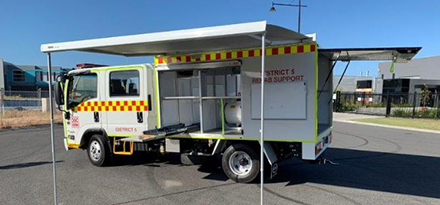South West Victorian firefighters will have more support when fighting fires, with CFA welcoming a new rehab vehicle for District 5. The purpose-built truck includes crucial equipment such as cooling chairs and health monitoring systems to help the rehab team provide much-needed assistance at major incidents. Source: Timberbiz
D5 Assistant Chief Fire Officer Richard Bourke welcomed the addition to the fleet, saying heat stress and dehydration are dangers that confront emergency responders working under pressure, particularly in hot weather or hot situations.
“The Rehabilitation and Health Monitoring Unit will no doubt provide valuable resources to our emergency services personal during an incident. After successful completion of a Health Monitoring course our volunteers can perform basic health monitoring including checking vital signs such as temperature, blood oxygen levels, blood pressure and carbon monoxide monitoring,” he said.
District 5 Headquarters Brigade Captain Ron Eastwood said the unit will be based in Hamilton and usually respond with at least three members, one of whom will be a qualified health professional such as doctor, nurse or paramedic.
“The rehab team is one of the many ways that people can volunteer with CFA without being a traditional firefighter,” he said.
Mr Eastwood said members last month trained in the use of the vehicle, which can be driven on a regular car driver’s licence and look forward to starting to use it at incidents from this month.
“The health, safety and welfare of emergency responders is paramount. The Rehab Unit will enable us to provide a much-needed service in south west and western Victoria that has not been readily available in this part of the state,” he said.
“As the nearest unit to us is Smythesdale, 180 kilometres away, our operating territory will be approximately 100-kilometre radius.
“Rehabilitation has been shown to significantly reduce the incidence of heat-related illness. Rehabilitation allows responders to rest and restore their hydration levels and core body temperature to levels that are safe to continue participating in the response tasks.”
The new vehicle was funded through the Victorian Government’s Volunteer Emergency Services Equipment Program.








